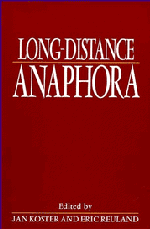Book contents
- Frontmatter
- Contents
- List of contributors
- Preface
- 1 Long-distance anaphora: an overview
- 2 Containment and connectedness anaphors
- 3 Long-distance reflexives and the typology of NPs
- 4 Contextual determination of the anaphor/pronominal distinction
- 5 On the interaction between antecedent-government and binding: the case of long-distance reflexivization
- 6 Binding in Polish
- 7 Anaphors in binary trees: an analysis of Czech reflexives
- 8 Latin long-distance anaphora
- 9 Prepositions, binding and θ-marking
- 10 Locality, parameters and some issues in Italian syntax
- 11 Long-distance binding in Finnish
- 12 The primacy condition of anaphora and pronominal variable binding
- 13 The local nature of the long-distance reflexive in Chinese
- 14 Anaphors and logophors: an argument structure perspective
- References
- Index
Preface
Published online by Cambridge University Press: 01 June 2011
- Frontmatter
- Contents
- List of contributors
- Preface
- 1 Long-distance anaphora: an overview
- 2 Containment and connectedness anaphors
- 3 Long-distance reflexives and the typology of NPs
- 4 Contextual determination of the anaphor/pronominal distinction
- 5 On the interaction between antecedent-government and binding: the case of long-distance reflexivization
- 6 Binding in Polish
- 7 Anaphors in binary trees: an analysis of Czech reflexives
- 8 Latin long-distance anaphora
- 9 Prepositions, binding and θ-marking
- 10 Locality, parameters and some issues in Italian syntax
- 11 Long-distance binding in Finnish
- 12 The primacy condition of anaphora and pronominal variable binding
- 13 The local nature of the long-distance reflexive in Chinese
- 14 Anaphors and logophors: an argument structure perspective
- References
- Index
Summary
This volume is a collection of original articles on the nature of the anaphoric systems in a variety of languages and from a number of different perspectives. The aim of the editors is to provide a new impetus to the study of long-distance anaphors, a phenomenon with ramifications that are rather puzzling from the perspective of the binding theory in its canonical form (as in Chomsky (1981)). All of the contributions are concerned with extending that theory in a manner that is as restrictive as possible. Some of the solutions solidly remain within the domain of the structural binding theory. In other cases, developing a restrictive theory required recognizing different components in binding, and assigning a specific role to pragmatic factors. Many of the articles converge, however, in important respects, leading to considerable simplification of the overall picture. The patterns found in the languages covered are so consistent that they cannot be accidental (although one would certainly wish to investigate a larger number of languages).
Most of the articles originated as contributions to a workshop on long-distance anaphora organized by the Department of Linguistics of Groningen University, 18–20 June 1987. The editors added a first chapter in which the main results of the volume are put together. The original plans were for this chapter to be written by the editors together with Tanya Reinhart, who participated in the workshop as a discussant.
- Type
- Chapter
- Information
- Long Distance Anaphora , pp. xi - xiiPublisher: Cambridge University PressPrint publication year: 1991

